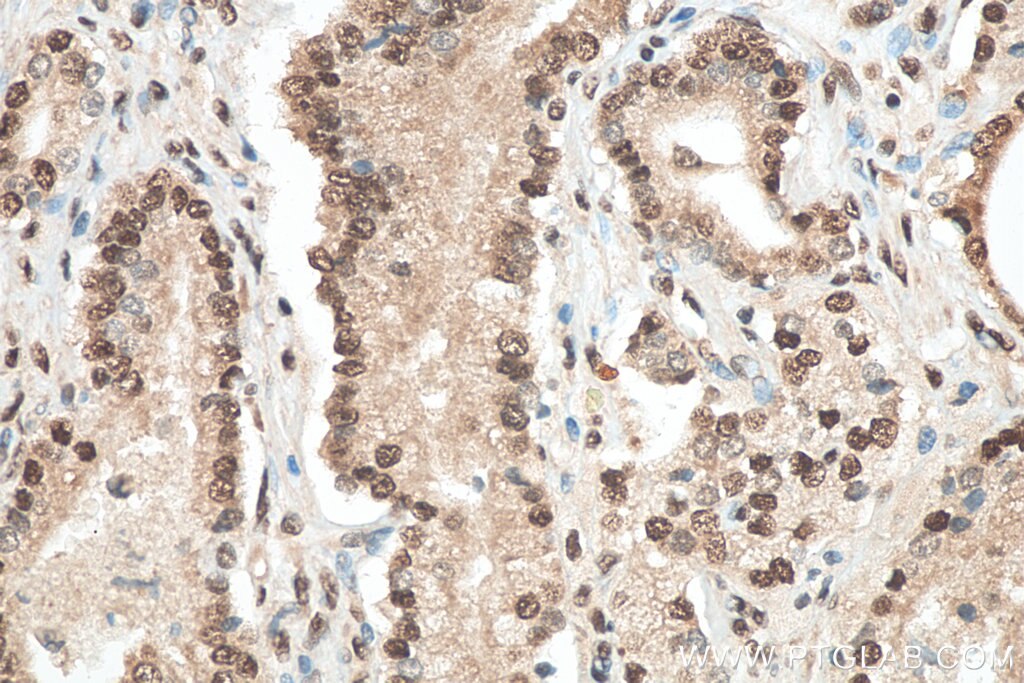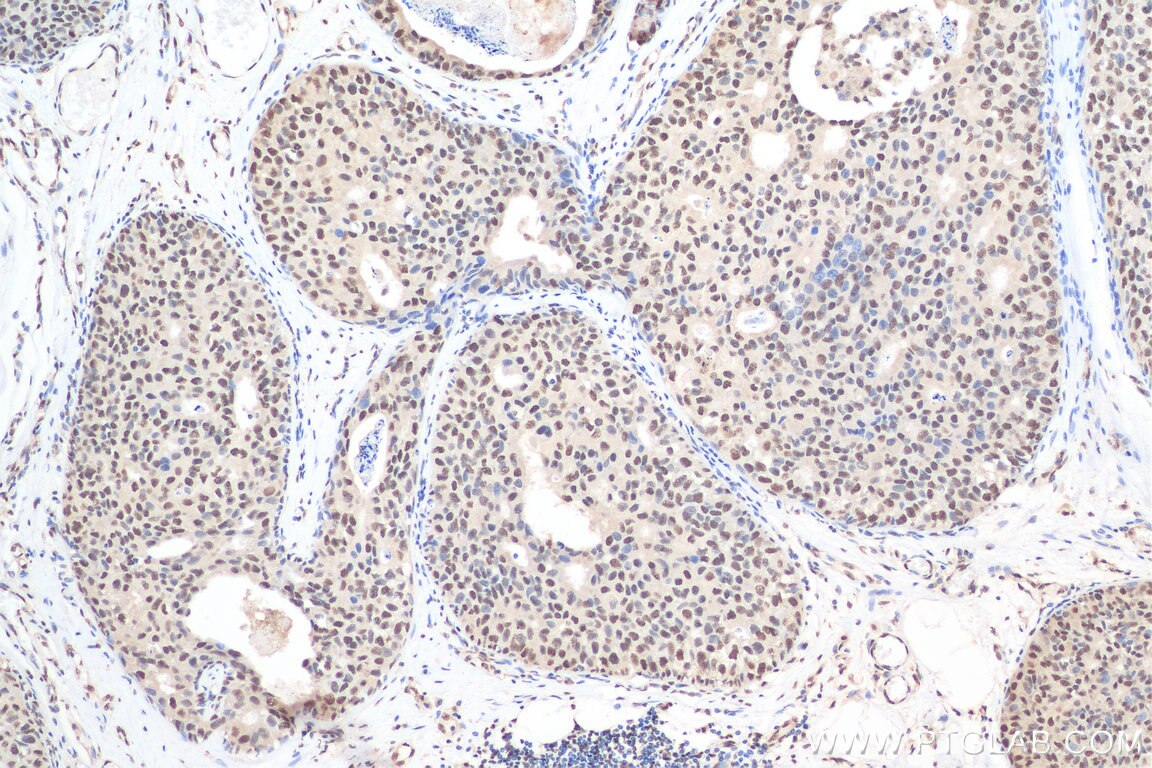- Featured Product
- KD/KO Validated
C14orf166 Polyklonaler Antikörper
C14orf166 Polyklonal Antikörper für IF, IHC, IP, WB, ELISA
Wirt / Isotyp
Kaninchen / IgG
Getestete Reaktivität
human, Maus, Ratte
Anwendung
WB, IP, IHC, IF, ELISA
Konjugation
Unkonjugiert
Kat-Nr. : 19848-1-AP
Synonyme
Galerie der Validierungsdaten
Geprüfte Anwendungen
| Erfolgreiche Detektion in WB | A549-Zellen, Jurkat-Zellen, Mauslungengewebe, Maus-Pankreasgewebe |
| Erfolgreiche IP | Jurkat-Zellen |
| Erfolgreiche Detektion in IHC | humanes Mammakarzinomgewebe, humanes Prostatakarzinomgewebe Hinweis: Antigendemaskierung mit TE-Puffer pH 9,0 empfohlen. (*) Wahlweise kann die Antigendemaskierung auch mit Citratpuffer pH 6,0 erfolgen. |
| Erfolgreiche Detektion in IF | Jurkat-Zellen |
Empfohlene Verdünnung
| Anwendung | Verdünnung |
|---|---|
| Western Blot (WB) | WB : 1:1000-1:6000 |
| Immunpräzipitation (IP) | IP : 0.5-4.0 ug for 1.0-3.0 mg of total protein lysate |
| Immunhistochemie (IHC) | IHC : 1:50-1:500 |
| Immunfluoreszenz (IF) | IF : 1:50-1:500 |
| It is recommended that this reagent should be titrated in each testing system to obtain optimal results. | |
| Sample-dependent, check data in validation data gallery | |
Veröffentlichte Anwendungen
| KD/KO | See 1 publications below |
| WB | See 6 publications below |
| IHC | See 4 publications below |
Produktinformation
19848-1-AP bindet in WB, IP, IHC, IF, ELISA C14orf166 und zeigt Reaktivität mit human, Maus, Ratten
| Getestete Reaktivität | human, Maus, Ratte |
| In Publikationen genannte Reaktivität | human, Maus |
| Wirt / Isotyp | Kaninchen / IgG |
| Klonalität | Polyklonal |
| Typ | Antikörper |
| Immunogen | C14orf166 fusion protein Ag13900 |
| Vollständiger Name | chromosome 14 open reading frame 166 |
| Berechnetes Molekulargewicht | 244 aa, 28 kDa |
| Beobachtetes Molekulargewicht | 28 kDa |
| GenBank-Zugangsnummer | BC001722 |
| Gene symbol | C14orf166 |
| Gene ID (NCBI) | 51637 |
| Konjugation | Unkonjugiert |
| Form | Liquid |
| Reinigungsmethode | Antigen-Affinitätsreinigung |
| Lagerungspuffer | PBS mit 0.02% Natriumazid und 50% Glycerin pH 7.3. |
| Lagerungsbedingungen | Bei -20°C lagern. Nach dem Versand ein Jahr lang stabil Aliquotieren ist bei -20oC Lagerung nicht notwendig. 20ul Größen enthalten 0,1% BSA. |
Hintergrundinformationen
Human CLE/C14orf166 protein is a positive modulator of cellular RNA polymerase. CLE is also shown to interact with the influenza virus polymerase complex and colocalizes with viral ribonucleoproteins, and is required for viral replication. Similarly, CLE is identified as a novel host interacting partners of the mature hepatitis C virus core protein. CLE levels were significantly higher in the serum of patients with PaCa compared with the control group was strongly expressed in tumor cells, suggesting that C14orf166 may be a potential biomarker of pancreatic adenocarcinoma.
Protokolle
| Produktspezifische Protokolle | |
|---|---|
| WB protocol for C14orf166 antibody 19848-1-AP | Protokoll herunterladen |
| IHC protocol for C14orf166 antibody 19848-1-AP | Protokoll herunterladen |
| IF protocol for C14orf166 antibody 19848-1-AP | Protokoll herunterladen |
| IP protocol for C14orf166 antibody 19848-1-AP | Protokoll herunterladen |
| Standard-Protokolle | |
|---|---|
| Klicken Sie hier, um unsere Standardprotokolle anzuzeigen |
Publikationen
| Species | Application | Title |
|---|---|---|
Nucleic Acids Res A novel all-in-one conditional knockout system uncovered an essential role of DDX1 in ribosomal RNA processing. | ||
Biosci Rep Overexpressed C14orf166 associates with disease progression and poor prognosis in non-small cell lung cancer. | ||
J Transl Med C14orf166 overexpression correlates with tumor progression and poor prognosis of breast cancer.
| ||
Tumour Biol C14ORF166 overexpression is associated with pelvic lymph node metastasis and poor prognosis in uterine cervical cancer. | ||
Tumour Biol Overexpression of chromosome 14 open reading frame 166 correlates with disease progression and poorer prognosis in human NPC. | ||
Mol Med Rep Expression and clinical significance of C14orf166 in esophageal squamous cell carcinoma. |











